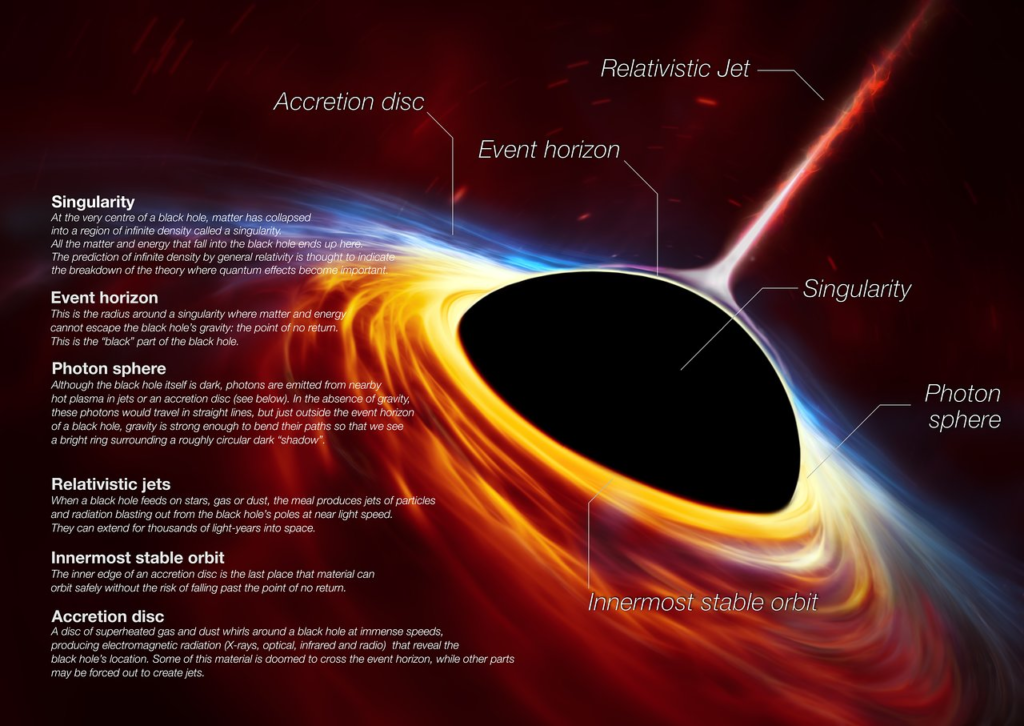At InclusiveIAS, we understand the significance of Science and Technology in the UPSC Prelims and the challenges students face in mastering this subject. To address these issues, we have launched Science Corner, a dedicated space where aspirants can access comprehensive and meticulously curated notes tailored specifically for Prelims. Our aim is to simplify complex topics, align content with the evolving exam trends, and empower aspirants with a strong foundation to tackle Science and Technology questions confidently.By bridging the gap between complexity and clarity, this initiative reflects our philosophy of making UPSC preparation inclusive, effective, and student-centric.
Black Holes
- A black hole is an area of such immense gravity that nothing — not even light — can escape from it
- Albert Einstein first predicted the existence of black holes in 1916, with his general theory of relativity.
|
Types of Black holes:
Black holes can be divided into three categories according to their mass:
- Stellar Mass Black Holes:
- If a star had around 20 times the Sun’s mass or more, the star’s core collapses into a stellar-mass black hole.
- These are born from the death of stars much more massive than the Sun. When some of these stars run out of the nuclear fuel that makes them shine, their cores collapse into black holes under their own gravity.
- Other stellar mass black holes form from the collision of neutron stars.
- These are probably the most common black holes in the cosmos.
- Supermassive Black Holes
- These are the monsters of the universe, living at the centers of nearly every galaxy.
- They range in mass from 100,000 to billions of times the mass of the Sun, far too massive to be born from a single star.
- Supermassive black holes can grow by feeding on smaller objects, like their stellar-mass relatives and neutron stars. They can also merge with other supermassive black holes when galaxies collide.
- Intermediate Mass Black Holes
- They weigh 100 to 10,000 times the mass of the Sun, putting them between stellar and supermassive black holes.
|
At the heart of the Milky Way lies a supermassive black hole — Sagittarius A*. |
|
The first image of a black hole was captured in 2019 by the Event Horizon Telescope (EHT) collaboration. |
Formation of black holes:
Black holes form via two distinct ways:
- They are stellar corpses, so they form when massive stars die. Stars whose birth masses are above roughly 8 to 10 times the mass of our sun, when they exhaust all their fuel — their hydrogen — they explode and die leaving behind a very compact dense object, a black hole. The resulting black hole that is left behind is referred to as a stellar mass black hole and its mass is of the order of a few times the mass of the sun.
- Formation of black holes through direct collapse of gas.Its a process that is expected to result in more massive black holes with a mass ranging from 1000 times the mass of the sun up to even 100,000 times the mass of the sun. This channel circumvents the formation of the traditional star, and is believed to operate in the early universe and produce more massive black hole seeds.
|
Not all stars leave behind black holes, stars with lower birth masses leave behind a neutron star or a white dwarf. |
Structure:
- Black holes have three “layers”: the outer and inner event horizon, and the singularity.
- The event horizon of a black hole is the boundary around the mouth of the black hole, past which light cannot escape. Once a particle crosses the event horizon, it cannot leave. Gravity is constant across the event horizon.
- The inner region of a black hole, where the object’s mass lies, is known as its singularity, the single point in space-time where the mass of the black hole is concentrated.
How Black Holes are detected?
Black holes don’t emit or reflect light, making them effectively invisible to telescopes. Scientists primarily detect and study them based on how they affect their surroundings:
- A supermassive black hole’s intense gravity can cause stars to orbit around it in a particular way.
- Black holes can be surrounded by rings of gas and dust, called accretion disks, that emit light across many wavelengths, including X-rays.
- When very massive objects accelerate through space, they create ripples in the fabric of space-time called gravitational waves. Scientists can detect some of these by the ripples’ effect on detectors.
|
All black holes spin. |
- Massive objects like black holes can bend and distort light from more distant objects. This effect, called gravitational lensing, can be used to find isolated black holes that are otherwise invisible.
Ergosphere:
- Rotating black holes (a.k.a. Kerr black holes) have a unique feature: a region outside their outer event horizon called the ergosphere.
- It is a bigger sphere, outside the event horizon of a black hole, where matter can enter and then return (escape the black hole’s gravitational pull), if they are moving with speeds very close to the speed of light.
- The label ‘ergosphere’ comes from ‘ergon’, the Greek word for ‘work’. It is so named because it is possible to extract matter and energy from the ergosphere, but not from beyond the event horizon.
- In the Ergosphere, spacetime is dragged along with the rotation of the black hole.
Spaghettification.
- It describes what happens when matter gets too close to a black hole. It’s squeezed horizontally and stretched vertically, resembling a noodle.
|
The nearest known black hole is Gaia BH 1. |


